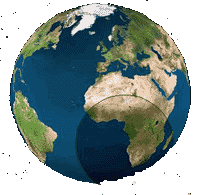|
Why
Eclipses Happen
Continued
|

Seen from the
moon, the moon's shadow looked like this when we were in total
eclipse in Zambia, June 21, 2001. The large gray
circle
is the penumbra from which only a partial eclipse was seen;
the small circle in the center is the tiny umbra from which the
total eclipse was seen.
See a Quicktime
movie of the moon's shadow on the earth as it traces out this eclipse:
(Note that
the earth is rotating and that the stars seem to move behind the
earth because of the moon's revolution in its orbit.) This is seen
as if viewed from the moon. Just by coincidencen the beautiful Trifid Nebula is in our view!
|
|

Total eclipses
seem to happen infrequently. Why doesn't the moon get between the
sun and the earth every month at new moon and produce an eclipse?
Because I've oversimplified matters. The real situation is a little
more complicated. We need to discuss the orbit of the earth around
the sun and the orbit of the moon around the earth. The orbits of
both are not circles, but rather slightly oval-shaped ellipses.
Also, these orbits do not lie parallel to each other in the same
plane.
As the earth
orbits the sun, taking one year to complete one circuit, it appears
to us on earth that the sun moves around our sky once against the
background of stars. Here's an analogy--If you walk around a campfire
(the sun) looking at your friends on the other side (the stars),
to you it would look like the campfire moves past your friends.
Likewise, from earth, it looks like the sun moves against the background
of stars, making one circuit of the sky in one year.
If the sun
could draw a line as it moved against the stars, we would see
 a great circle called
the ecliptic. If we could ask the moon to also draw a line in the
sky as it orbited the earth, we'd notice that the two lines would
be close to each other, but the moon's path is tilted about 5 degrees
to the path of the sun.
a great circle called
the ecliptic. If we could ask the moon to also draw a line in the
sky as it orbited the earth, we'd notice that the two lines would
be close to each other, but the moon's path is tilted about 5 degrees
to the path of the sun.
This is why
the moon doesn't eclipse the sun every month. Most of the time,
the moon passes over or under the sun. An eclipse can happen only
when both the sun and the moon arrive near one of the crossing points
(these are called nodes). There are two of these nodes on opposite
sides of the sky, one where the moon crosses from south to north,
and one where the moon passes from north to south. Since there are
two crossing points in the sky, eclipses happen during two "eclipse
seasons" separated by about six months.

The sun does
not have to be exactly on the node when the moon arrives there,
only close enough for the moon to block some portion of the sun.
This leaves a "window" of about 18.75 days before and
after the sun gets to the nodes. During this 37.5-day period, the
moon can cause an eclipse. Since the moon takes 29.5 days to go
from new moon to new moon, this means that an eclipse of some kind
is guaranteed about every six months.
|
|
The
type of eclipse that
does
occur depends on several things.
First, if the eclipse happens when the sun is further from the node,
it is more likely that the eclipse will be a partial one. In this
type of eclipse, the dark umbra passes above the North Pole or below
the South Pole, never touching the earth. All we ever see is part
of the sun covered.

There's another
variable, though. Remember that the orbits of the earth and moon
are not perfect circles, but rather ellipses. Note that in the diagram
above (again wildly out of scale), the earth is sometimes closer
to the sun and sometimes further. The same is true for the moon--sometimes
it's closer to the earth and sometimes it's further. See the table
below:
|
|
Close
Distance
|
Far
Distance
|
Sun
|
147,101,455
km
|
152,098,155
km
|
Moon
|
356,749
km
|
406,282
km
|
As you can
see, both the sun and the moon change their distances quite significantly.
The moon changes by about 14 per cent, and we vary our distance
to the sun by about 3 per cent. Because of this, the sun and moon
look bigger sometimes and smaller at other times. If we're far from
the sun so that it looks smaller, and close to the moon so it looks
bigger, the moon will be able to cover over the entire face of the
sun as seen from earth, and we'll see a total eclipse. If the opposite
is true and we're close to the sun and far from the moon, the moon
will appear too small to cover the face of the sun.
In this case,
it's like trying to cover a penny with a dime. You would see a ring
of copper penny sticking out on all sides of the dime. This happens
with the sun and moon. You see a ring of the sun shining around
the edges of the moon. This is called an "annular" eclipse
(annular comes from the Latin
annulus
or ring). In an annular
eclipse, you don't get to see any of the "special effects"
of a total eclipse, such as the corona, or diamond ring effect.
The thin sliver peeking around the moon is far too bright to allow
this.
More on this
in another section "
What to see...
"
|
|